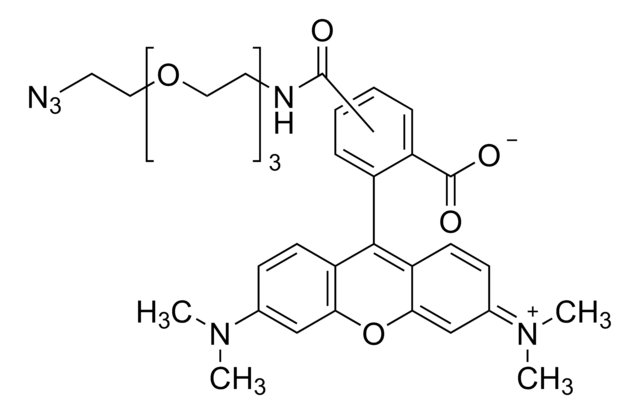41986
Atto 550 azide
BioReagent, suitable for fluorescence
Sign Into View Organizational & Contract Pricing
All Photos(1)
About This Item
UNSPSC Code:
12352125
NACRES:
NA.32
Recommended Products
product line
BioReagent
Assay
>90% (HPLC)
manufacturer/tradename
ATTO-TEC GmbH
transmittance
254 nm
550 nm
fluorescence
λex 554 nm; λem 576 nm±10 nm in 0.1 M phosphate pH 7.0
λ
(ethanol with 0.1% trifluoroacetic acid)
UV absorption
λ: 553-559 nm Amax
suitability
suitable for fluorescence
storage temp.
−20°C
Legal Information
This product is for Research use only. In case of intended commercialization, please contact the IP-holder (ATTO-TEC GmbH, Germany) for licensing.
Storage Class Code
11 - Combustible Solids
WGK
WGK 3
Flash Point(F)
Not applicable
Flash Point(C)
Not applicable
Certificates of Analysis (COA)
Search for Certificates of Analysis (COA) by entering the products Lot/Batch Number. Lot and Batch Numbers can be found on a product’s label following the words ‘Lot’ or ‘Batch’.
Already Own This Product?
Find documentation for the products that you have recently purchased in the Document Library.
Smart-aggregation imaging for single molecule localization with SPAD cameras.
Gyongy, I.; et al.
arXiv (2016)
Rula Masoud et al.
ACS nano, 6(7), 6272-6283 (2012-06-06)
We present a test case example of a detailed single-molecule fluorescence study of one of the most sophisticated and complex DNA devices introduced to date, a recently published autonomous bipedal DNA motor. We used the diffusion-based single-molecule Förster resonance energy
Robert H Meltzer et al.
Lab on a chip, 11(5), 863-873 (2011-01-21)
Rapid, specific, and sensitive detection of airborne bacteria, viruses, and toxins is critical for biodefense, yet the diverse nature of the threats poses a challenge for integrated surveillance, as each class of pathogens typically requires different detection strategies. Here, we
A molecular toolkit for population genetic investigations of the ash dieback pathogen Hymenoscyphus pseudoalbidus.
Gross, A., et al.
Forest Pathology, 42, 252-264 (2012)
Rahul Roy et al.
Nature methods, 5(6), 507-516 (2008-05-31)
Single-molecule fluorescence resonance energy transfer (smFRET) is one of the most general and adaptable single-molecule techniques. Despite the explosive growth in the application of smFRET to answer biological questions in the last decade, the technique has been practiced mostly by
Our team of scientists has experience in all areas of research including Life Science, Material Science, Chemical Synthesis, Chromatography, Analytical and many others.
Contact Technical Service




